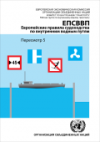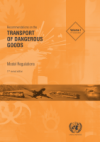Publications
Displaying Results 61 - 80 of 199
- English
CEVNI contains the core rules applicable to the traffic on inland waterways in the UNECE region such as marks and draught scales on vessels, visual signals on vessels, sound signals and radiotelephony, waterway signs and markings, rules of the road, berthing rules, signalling and reporting requirements as well as prevention of pollution of water and disposal of waste. These harmonized
- English
The European Agreement concerning the International Carriage of Dangerous Goods by Inland Waterways (ADN) done at Geneva on 26 May 2000 under the auspices of the United Nations Economic Commission for Europe (UNECE) and the Central Commission for Navigation on the Rhine (CCNR) has been in force since February 2008. The Agreement currently has eighteen Contracting Parties.The Regulations
- English
Adopted on 30 September 1957 in Geneva under the auspices of the United Nations Economic Commission for Europe (UNECE), the ADR entered into force on 29 January 1968. This authoritative Agreement is intended to increase the safety of international transport of dangerous goods by road. Its Annexes A and B contain the technical requirements for road transport, i.e. the conditions under
- English
The Manual of Tests and Criteria contains criteria, test methods and procedures to be used for classification of dangerous goods according to the provisions of Parts 2 and 3 of the United Nations Recommendations on the Transport of Dangerous Goods, Model Regulations, as well as of chemicals presenting physical hazards according to the Globally Harmonized System of Classification and Labelling
- English
These recommendations have been developed in the light of technical progress, the advent of new substances and materials, the exigencies of modern transport systems and, above all, the requirement to ensure the safety of people, property and the environment. They are addressed to governments and international organisations concerned with the regulation of the transport of dangerous goods. The
- English
The GHS addresses classification of chemicals by types of hazard and proposes harmonized hazard communication elements, including labels and safety data sheets. It aims at ensuring that information on physical hazards and toxicity from chemicals be available in order to enhance the protection of human health and the environment during the handling, transport and use of these chemicals.The GHS
- Pусский
Content
The first section describes the TIR transit system, its coverage, objective and functioning and analyses possible future developments.
The second section contains the complete text of the TIR Convention.
The third section contains related resolutions and recommendations.
- Français
Content
The first section describes the TIR transit system, its coverage, objective and functioning and analyses possible future developments.
The second section contains the complete text of the TIR Convention.
The third section contains related resolutions and recommendations.
- العربية
Content
The first section describes the TIR transit system, its coverage, objective and functioning and analyses possible future developments.
The second section contains the complete text of the TIR Convention.
The third section contains related resolutions and recommendations.
- Español
Content
The first section describes the TIR transit system, its coverage, objective and functioning and analyses possible future developments.
The second section contains the complete text of the TIR Convention.
The third section contains related resolutions and recommendations.
- English
Content
The first section describes the TIR transit system, its coverage, objective and functioning and analyses possible future developments.
The second section contains the complete text of the TIR Convention.
The third section contains related resolutions and recommendations.
- 汉语
Content
The first section describes the TIR transit system, its coverage, objective and functioning and analyses possible future developments.
The second section contains the complete text of the TIR Convention.
The third section contains related resolutions and recommendations.
- English
The objective of the “Blue book” is to establish an inventory of existing and envisaged standards and parameters of E waterways and ports in Europe and to show, on an internationally comparable basis, the current inland navigation infrastructure parameters in Europe as compared to the minimum standards and parameters prescribed on the Agreement on Main Inland Waterways of International
- English
The European Agreement concerning the International Carriage of Dangerous Goods by Inland Waterways (ADN) done at Geneva on 26 May 2000 under the auspices of the United Nations Economic Commission for Europe (UNECE) and the Central Commission for Navigation on the Rhine (CCNR) has been in force since February 2008. The Agreement currently has seventeen Contracting Parties.The Regulations
- English
Adopted on 30 September 1957 in Geneva under the auspices of the United Nations Economic Commission for Europe (UNECE), the ADR entered into force on 29 January 1968. This authoritative Agreement is intended to increase the safety of international transport of dangerous goods by road. Its Annexes A and B contain the technical requirements for road transport, i.e. the conditions under
- English
The TEM and TER revised Master Plan Final report consists of two Volumes - Volume l, containing the main text and Volume II – Annexes.Volume I: Main textVolume II: AnnexesVolume I, is being
- English
The Manual of Tests and Criteria contains criteria, test methods and procedures to be used for classification of dangerous goods according to the provisions of Parts 2 and 3 of the United Nations Recommendations on the Transport of Dangerous Goods, Model Regulations, as well as of chemicals presenting physical hazards according to the Globally Harmonized System of Classification and Labelling
- English
The UNECE Recommendations on Harmonized Europe-Wide Technical Requirements for Inland Navigation Vessels (Resolution No. 61) establish a Pan-European regime of technical requirements for inland navigation vessels engaged in international transport of goods and passengers. They are a result of Governments efforts, aimed at unifying the divergent regulations in force within different
- English
These recommendations have been developed in the light of technical progress, the advent of new substances and materials, the exigencies of modern transport systems and, above all, the requirement to ensure the safety of people, property and the environment. They are addressed to governments and international organisations concerned with the regulation of the transport of dangerous goods. The
- English
The GHS addresses classification of chemicals by types of hazard and proposes harmonized hazard communication elements, including labels and safety data sheets. It aims at ensuring that information on physical hazards and toxicity from chemicals be available in order to enhance the protection of human health and the environment during the handling, transport and use of these chemicals. The GHS














